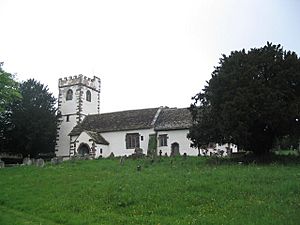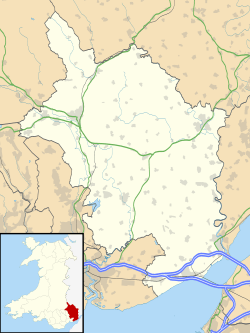St Cadoc's Church, Llangattock Lingoed facts for kids
Quick facts for kids Church of St Cadoc, Llangattock Lingoed |
|
|---|---|

Church of St Cadoc
|
|
| 51°52′30″N 2°55′39″W / 51.8750°N 2.9276°W | |
| Location | Monmouth, Monmouthshire |
| Country | Wales |
| Denomination | Church in Wales |
| History | |
| Status | Grade I |
| Architecture | |
| Style | Perdendicular |
| Years built | 14th/15th century |
| Administration | |
| Diocese | Monmouth |
The Church of St Cadoc is a very old church in a village called Llangattock Lingoed in Monmouthshire, Wales. It sits right in the middle of the village. This church is special because it's built in a style called Perpendicular Gothic, which was popular a long time ago. It's also a Grade I listed building, which means it's super important and protected because of its history and beauty.
The Church's Story and Style
This church is very old, built during the Middle Ages (that's what 'medieval' means!). It's made from a type of rock called Old Red Sandstone and has a roof made of stone tiles. The main part of the church, called the nave, is quite long. It ends with a tall tower that has a cool, castle-like top called a battlement.
The church is named after a Welsh holy person, Saint Cadoc. Over the years, the church has been looked after and repaired. In the 1800s, it had a big restoration, which means it was fixed up a lot. This work was done by an architect named John Prichard after one of the walls fell down.
Amazing Art Inside
Inside the church, you can find a really big wall painting from the early 1400s. It shows St George fighting and defeating a dragon! Some people think this painting might also be a secret message about important battles that happened nearby. These battles were when the Welsh leader Owain Glyndŵr was defeated by the English in places like Campston Hill (in 1404) and Grosmont (in 1405). These places are very close to Llangattock Lingoed.
Old Furniture and Features
You can also see some very old wooden benches, called pews, from the 1500s. An expert on old buildings, John Newman, says these pews are "a rare survival," meaning it's very unusual to find them still around today. There's also a wooden beam with beautiful carvings of vine leaves and grapes. This beam is a piece of a rood screen from the late 1400s, which was a special screen that used to separate parts of the church.
Outside in the churchyard, there's a medieval cross. This cross is also a protected historical item, listed as Grade II.


